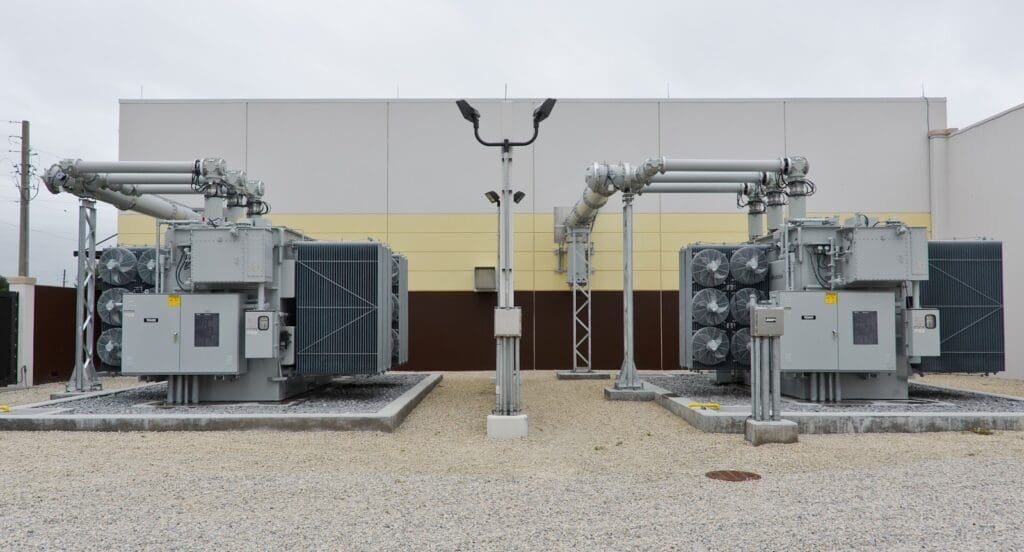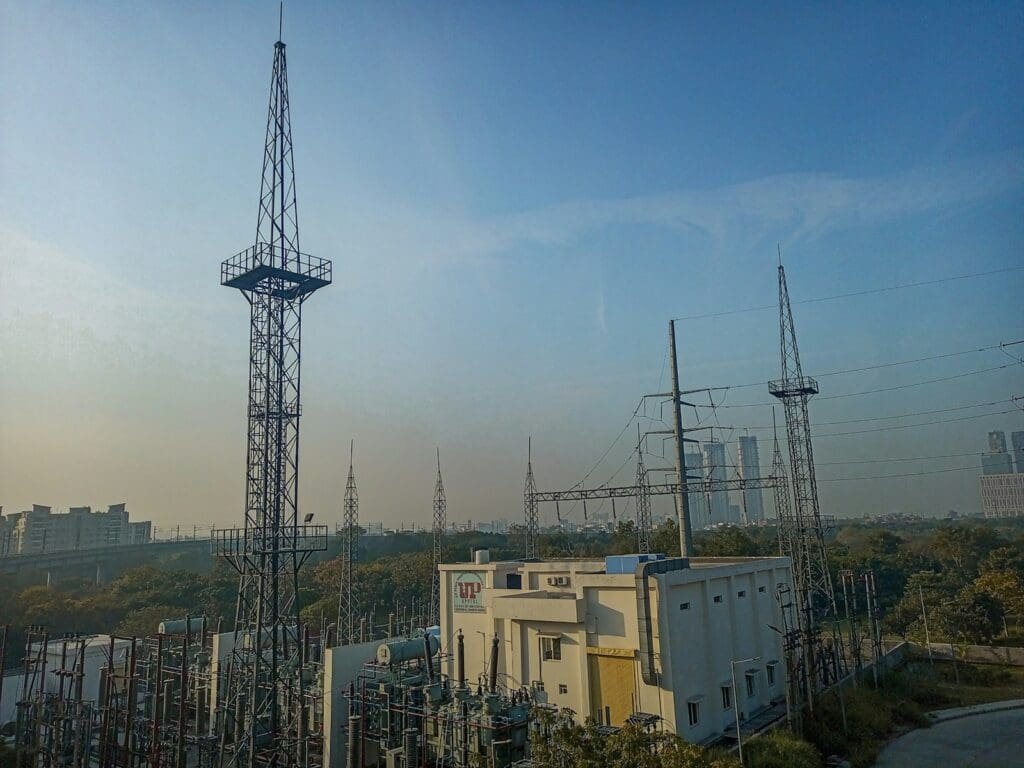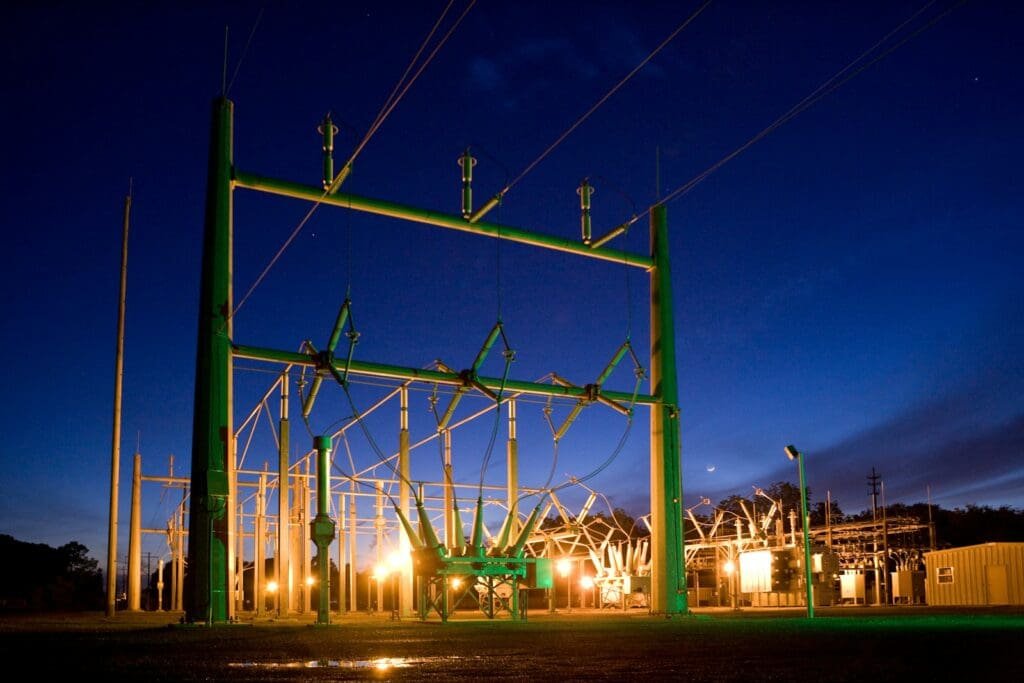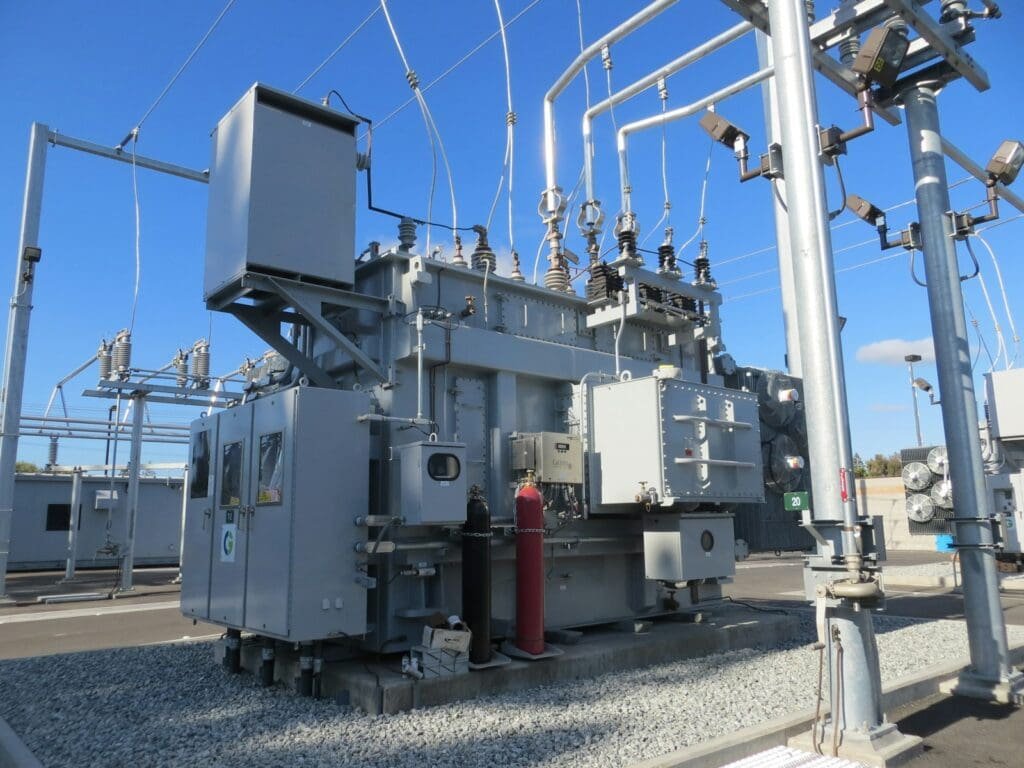Introduction To Electrical Substations
Did you know the robust power grid that remarkably keeps your lights on, powers your devices, and keeps industries running is made up of multiple complex systems working in harmony?
In this post, we’ll be powering through the fascinating world of electrical distribution, specifically focusing on transmission substations, their defining traits, and the crucial roles they play in the power grid.
We’ll also head into the difference between transmission and subtransmission, explore distribution substations, and get acquainted with converter substations. Lastly, we’ll scrutinize the final phase in the delivery of electric power which occurs in electrical distribution systems, and highlight the distinctions between these systems and substations.
Ready to illuminate your understanding of the workings of the power grid? Let’s flip the switch and get started.
Table of Contents
A Closer Look at Transmission Substations

Defining Transmission Substations
A transmission substation is an integral part of the electrical generation, transmission, and distribution system. It acts as a connecting link between the power generation station and the distribution area. It is a critical component in regulating and directing the flow of electricity from power plants to homes, businesses, and factories.
Functionality of Transmission Substations
1. Voltage Transformation
The primary function of a transmission substation is to transform voltage levels. It steps down the high voltage power generated at power plants to a level that can be distributed and used in homes and businesses.
2. Switching Operations
Another key function involves facilitating switching operations. It allows for isolation of equipment, rerouting of power and balancing the load to maintain an optimal, reliable power supply.
3. Monitoring and Control
Transmission substations also play a vital role in monitoring and controlling the operation of the grid. They use sophisticated equipment to keep track of system performance and respond to anomalies, therefore playing an integral part in maintaining system stability and safety.
| Functions | Description |
|---|---|
| Voltage Transformation | Modify voltage levels for effective electricity distribution |
| Switching Operations | Allow for isolation of equipment and rerouting of power |
| Monitoring and Control | Keep track of system performance and ensure system stability |
The Role of Transmission Substations in the Power Grid
Transmission substations form a crucial part of the entire power grid. They play an indispensable role in ensuring a continuous supply of electricity to consumers. They ensure power generated at generating stations reaches the end-users safely and efficiently.
To learn more about the intricate operations of transmission substations, you can take a deeper dive into this topic on the U.S. Department of Energy’s website.
Remember, the next time you switch on a light or charge your phone, it’s the quiet work of transmission substations that help make it possible, keeping the network functional and ensuring electricity is always there when you need it.
Discerning Transmission from Subtransmission

The Concept of Transmission
The term “transmission” in the context of electricity refers to the transportation of electric power from the generating stations where it’s produced, to the substations positioned near demand centers. It functions like an electric highway, where power travels at high voltages to mitigate power losses across long distances. The transmission system does more than carry power; it simultaneously stabilizes the alternating current frequency and maintains an optimal power flow between the generating stations and the areas of power usage.
The transmission grid is generally a highly interconnected network, allowing power generation to be distributed within a large geographic area. This interconnected structure enhances the reliability of the electrical grid by providing multiple pathways for power to flow, ensuring seamless transmission even if one path is compromised.
What is Subtransmission?
Not to be confused with transmission, “subtransmission” refers to an intermediate step in the electricity distribution process. It involves the transfer of electricity from transmission systems to the distribution substations. Subtransmission voltages are lower than those used in the main transmission lines but still higher than those used for final power distribution to homes, offices, or industrial plants.
Transmission Versus Subtransmission
Scope and Function
In comparing transmission versus subtransmission, it is essential to understand that transmission lines ferry electricity from power plants to geographically distant areas. They carry high-voltage electricity over significant distances. On the other hand, subtransmission lines function to transmit this electricity further but at lower voltages, bringing power closer to its final destination.
Voltage Levels
Another distinguishing feature between transmission and subtransmission is the voltage levels. Transmission lines typically carry electricity at very high voltages ranging from 69 to 765 kilovolts (kV). In comparison, subtransmission lines operate at lower voltage levels—usually between 33 and 69 kV.
Connectivity
Transmission lines typically connect generating stations directly to transmission substations, forming part of an extensive, interconnected network provides redundancy and improves reliability. Meanwhile, subtransmission lines connect transmission substations to distribution substations, aiding in the breakdown of power to voltages suitable for final customers.
| Characteristics | Transmission | Subtransmission |
|---|---|---|
| Scope and Function | Carry high-voltage electricity over long distances | Transmit electricity further at lower voltages |
| Voltage Levels | 69 to 765 kilovolts (kV) | 33 to 69 kilovolts (kV) |
| Connectivity | Connect generating stations to transmission substations | Connect transmission substations to distribution substations |
For more extensive knowledge about transmission and subtransmission, peruse through this U.S. Energy Information Administration’s guide. The comprehension of these two stages, their role, and contrasting features is central to understanding the delivery of electric power to end consumers efficiently and safely.
Exploring Distribution Substations

The Basics of Distribution Substations
Distribution substations are crucial components of the power distribution network. They form the next step in electricity distribution following the transmission and subtransmission stages. Found typically in residential areas or commercial zones, these substations receive power from the subtransmission lines and reduce the voltage further for safe use by homes and businesses.
Distribution substations convert the medium voltage power received from subtransmission lines into lower voltage electricity, which can be safely delivered to the end-users via distribution lines.
Key Functions of Distribution Substations
1. Voltage Reduction
The primary function of a distribution substation is to step down the voltage level received from subtransmission lines. This reduction is necessary to ensure safe domestic and commercial use.
2. Electrical Isolation
Distribution substations also provide a point of electrical isolation for the protection and maintenance of the power grid. They help mitigate any localized faults and prevent these from affecting a larger section of the grid.
3. Power Routing
Additionally, distribution substations control the routing of electricity to different distribution lines. They help ensure a balanced, reliable supply of power to each line, keeping the network functional and achieving efficient power distribution.
| Functions | Description |
|---|---|
| Voltage Reduction | Step down the voltage to a level safe for households and businesses |
| Electrical Isolation | Provide a buffer to prevent extensive power grid damage |
| Power Routing | Direct power to various distribution lines efficiently and reliably |
To comprehend more about distribution substations, you’re welcome to visit IEEE Xplore’s detailed resource on the topic.
Unveiling Converter Substations
Understanding Converter Substations
Though less common compared to transmission or distribution substations, converter substations play a vital role in specific scenarios. These specialized substations are typically used in interconnections of different power grids that operate with incompatible alternating current (AC) frequencies or for the linking of direct current (DC) energy sources or loads to the AC power grid.
Converter substations use power electronic devices to convert the type of current—AC to DC or vice versa—or to adjust the frequency of AC power.
Primary Applications of Converter Substations
1. HVDC Transmission
In high-voltage direct current (HVDC) transmission, converter substations are used at both ends of the transmission line: one substation converts AC to DC before transmitting, and the other one changes it back to AC before distribution.
2. Grid Interconnections
When two power systems with incompatible AC frequencies need to be interconnected, converter substations are put into play. They convert the frequency to a compatible level, allowing the two systems to interact.
3. Linking DC sources or loads
Converter substations are also employed when connecting DC energy sources or loads to the AC power grid. They facilitate the conversion process, ensuring the compatibility of the currents.
| Applications | Description |
|---|---|
| HVDC Transmission | Convert AC to DC for transmission and then back to AC for distribution |
| Grid Interconnections | Convert the frequency to make different power systems compatible |
| Linking DC sources/loads | Modify the type of current to match the AC power grid |
For more insight into converter substations, their functioning, and applications, you may visit this in-depth resource on ScienceDirect.
An Overview of Electrical Distribution
Defining Electrical Distribution
Electrical distribution refers to the final phase in the delivery of electric power. It carries electricity from the distribution substations to the end-users, such as residential homes, commercial establishments, and industrial facilities. Distribution systems employ lower voltage levels compared to transmission and subtransmission systems, as this power is utilized directly by consumers.
Main Tasks of an Electrical Distribution System
1. Power Delivery
The primary task of a distribution system is to deliver electricity to consumers. These can range from residential customers, commercial businesses, to industrial facilities. The distribution network must be robust and efficient enough to cater to different load demands and ensure supply continuity.
2. Voltage Regulation
One of the crucial tasks of the distribution system is voltage regulation. This ensures that voltage stay within predetermined limits, regardless of changes in the load or supply.
3. System Protection
A key aspect of distribution systems involves system protection. These networks include several protective devices to isolate faults and safeguard people and equipment from electric shocks or other electrical hazards.
| Tasks | Description |
|---|---|
| Power Delivery | Distribute electricity to various type of consumers |
| Voltage Regulation | Maintain voltage within the acceptable range |
| System Protection | Protect both the system and users from faults and electric hazards |
For a detailed understanding of electrical distribution, check out this comprehensive guide on the U.S. Department of Energy’s website.
Distinction Between Distribution Systems and Substations
The Interplay Between Substations and Distribution Systems
Both substations and distribution networks play indispensable roles in the functioning of the power grid. While they are parts of a unified system, they perform distinct functions in the process of delivering power from generation facilities to end-users.
Comparing Distribution Substations and Distribution Systems
The Role of Substations
As we’ve seen earlier, transmission and distribution substations perform several crucial tasks, such as stepping down voltage, isolating faults, facilitating switching operations and routing power. In essence, substations act as nerve centers—controlling and managing the flow of electricity.
The Role of Distribution Systems
On the other hand, distribution systems are responsible for delivering this managed and regulated power directly to consumers. They encompass a network of power lines, transformers and other equipment that carry electricity from distribution substations to households, businesses, and other facilities, ensuring that the demand for electric power is met.
| Aspects | Distribution Substations | Distribution Systems |
|---|---|---|
| Role | Control the flow of electricity and regulate the voltage | Deliver power from substations to consumers |
| Main Tasks | Voltage reduction, power routing, electrical isolation | Power delivery, voltage regulation, system protection |
While this distinction may seem subtle, the understanding of these roles is fundamental to the overall grasp of the delivery of electric power. For more detailed understanding of distribution systems and substations, check out this insightful resource on the U.S. Energy Information Administration’s website.
Conclusion: Powering Our Lives – Substations and Electrical Distribution Systems

Power generation and distribution is a complex process, relying on an intricate network of systems and facilities. At the heart of it all lie transmission, distribution, converter, and subtransmission substations. They function as essential links in the electricity supply chain, transforming, directing, and managing the flow of power. Whether it’s stepping down voltage levels, facilitating switching operations, or converting currents, substations ensure that electricity reaches us safely, reliably, and efficiently.
In close connection with substations, the electrical distribution system shoulders the responsibility of delivering this regulated power to consumers. It’s this collaborative mechanism, coupled with stringent system protection measures, that ensures a seamless flow of power to our homes, businesses, and factories, essentially powering our daily lives.
Frequently Asked Questions – FAQs
What’s the primary purpose of a transmission substation?
The main role of a transmission substation is to step-down the high voltage power from power plants to a level that can be safely distributed and utilized in homes and businesses.
How does subtransmission differ from transmission?
While transmission involves carrying high-voltage power over long distances, subtransmission takes this power and transmits it further but at lower voltages, bringing it closer to its final destination.
What function does a distribution substation serve?
Distribution substations receive power from subtransmission lines and reduce the voltage further for safe use by homes and businesses.
What scenarios require the use of converter substations?
Converter substations are used in scenarios such as HVDC transmission, interconnecting incompatible power systems, and linking DC energy sources or loads to the AC power grid.
What role does the electrical distribution system play?
The electrical distribution system’s role is to deliver power from the distribution substations to the end-users, conducting voltage regulation and ensuring system protection along the way.





